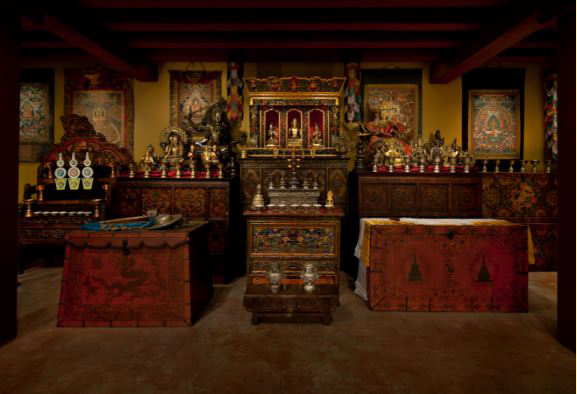


A passage from Herman Hesse’s Siddhartha quite adequately describes both the physical setup of the galleries of the Rubin Museum as well as the aspirations of the artworks they contain: “We are not going in circles, we are going upwards. The path is a spiral; we have already climbed many steps.”
Whenever I have a free minute in between meetings, I roam the galleries, trying to get a feel for the spaces and understand how visitors experience them for the first time. Being from the Swiss Alps—and hence sporting the legs of a mountain goat—I make use of Andrée Putman’s iconic spiral staircase that serves as the conceptual and physical backbone of our institution.
The Germanic people had the ash tree Yggdrasil at the center of the cosmos; in Buddhism and Hinduism, Meru takes up that function; the Swiss have the veritable Matterhorn (referred to in local dialect as Horu, or horn) and the “Rubin-verse” is rooted in Putman’s spiral. This axis mundi is very much worth climbing.

Made out of stainless steel and marble, the staircase seems to spiral up forever, topped only by a distant cupola lit by natural light. Likewise distant at this viewpoint at the base of the staircase is the “Restaurant at the End of the Universe,” the oasis Café Serai, awaiting the weary explorer with delicacies after considerable intellectual exertion.

A short flight of stairs takes one up to Gateway to Himalayan Art. You may not be able to tell a buddha from a bodhisattva; you might even think the Green Tara is a drink mixed in somber back alley bars in Tashkent to rival the Long Island Iced Tea. But no worries, by the end of a trip to Gateway, you will be enlightened and ready to move on to the third level.

The third floor’s Masterworks exhibition demands much more from visitors, by introducing stylistic developments across space and time. This is where the great collection of the Rubin Museum comes into play. You may be entranced by the outstanding works of art; you may be awestruck by the technical artistic achievements and back stories; or you may find delight in making stylistic connections all the way from the Indian subcontinent to Kashmir and the Tibetan Plateau. However, even the most seasoned museum-goer needs a rest at some point, and this is where the next floor comes in handy.

Sacred Spaces features our Tibetan Buddhist Shrine Room, a space for contemplating artworks in an immersive context. Surround yourself with the traditions of the Himalayas, take a breath, and hear distant Tibetan long horns while you gaze at the astonishing panoramic vista photographed in Mustang, Nepal.

And yes, you have arrived and are ready for the next two levels, which feature a home for our impressive roster of temporary exhibitions.

Jorrit Britschgi has served as the Rubin Museum’s Executive Director since 2017. Before joining the Rubin, he served as Head of Exhibitions and Publications at the Museum Rietberg in Zurich, Switzerland, where he was manager of the exhibitions program and curated numerous exhibitions. Mr. Britschgi also served as publisher of Artibus Asiae, one of the leading scholarly journals in Asian art and archaeology, for over a decade.
Jorrit Britschgi graduated from Zurich University with an MA in art history and Sinology (2005) and a PhD, with highest honors, in East Asian Art History (2009). Besides his research activities, he’s taken part in archaeological excavations in Eastern China and Bhutan, and curated numerous exhibitions on paintings from the Indian Himalayan region. Mr. Britschgi has received grants from federal and private foundations to pursue his studies and research. He is a 2017 alumni of the Getty Leadership Institute, and shares his expertise in an advisory capacity with other museums and individuals.
Get the latest news and stories from the Rubin, plus occasional information on how to support our work.